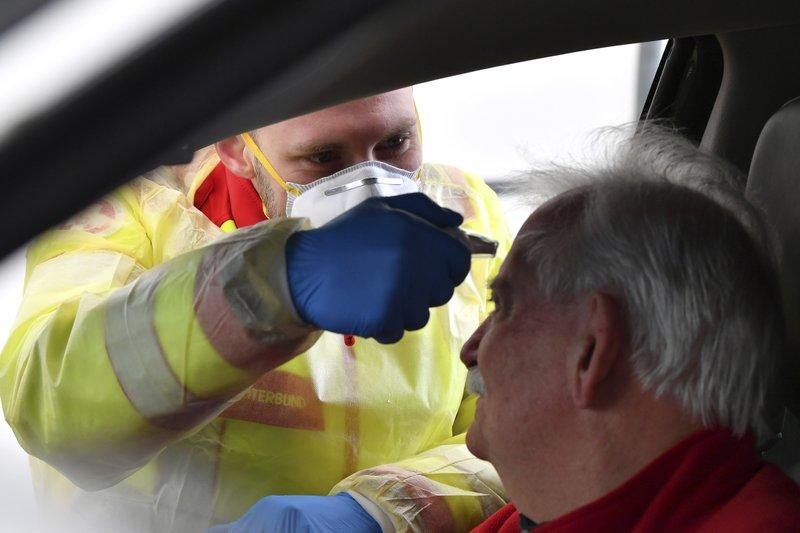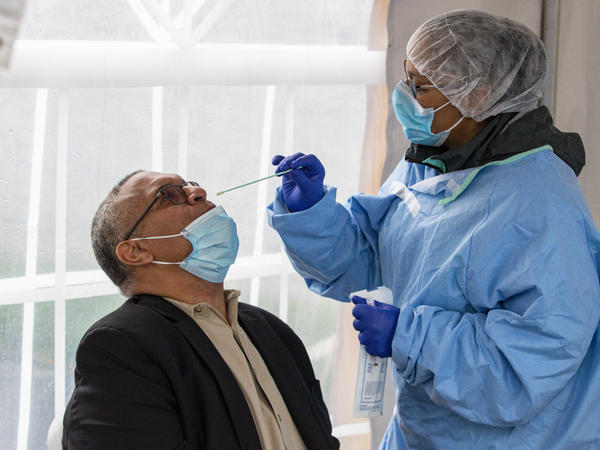Section Branding
Header Content
Georgia Coronavirus Updates: With 'Record' Numbers, Only 1.3% Of Georgians Tested
Primary Content
Georgia has surpassed 25,000 COVID-19 cases and 1,000 deaths but has tested a small fraction of the state's population. At the same time, the governor is weighing what to do with the shelter-in-place order expiring Thursday night.
As of 11:25 a.m. Wednesday, April 29, 1.3% of the state's 10 million residents have been tested for COVID-19. 25,274 people, or 18% of those tested, are positive for the virus. The reported death rate in Georgia is 4.16%, with 1,052 deaths confirmed.
Here is the latest Georgia coronavirus news for Thursday, April 30.
What’s next for shelter-in-place?
The big thing to watch for today is what Gov. Brian Kemp decides should happen with the state’s shelter-in-place order.
Currently, it is set to expire Thursday night, with “medically fragile” Georgians ordered to stay inside until the public health emergency expires May 13.
Kemp could extend the order for everyone through that time, or he could let it expire.
Other states and counties across the country have extended their respective orders, from several Bay Area counties in California keeping things shut down until the end of May to South Carolina, where restrictions now run until May 12.
More than 1,000 deaths marked statewide
Georgia surpassed 1,000 deaths from COVID-19 Monday night.
In Dougherty County, 118 people have died. That's about 1.31 people per 1,000 residents. But some surrounding southwest Georgia counties have an even higher death rate: in Randolph County, 2.8 deaths per 1,000; Terrell has seen 2.1 deaths per 1,000; Early, 1.48 deaths per 1,000.
For context, Fulton is Georgia’s most populous county, and the 108 deaths reported there equates to about .09 deaths per 1,000 residents – a death rate 30 times lower than Randolph County.
Black Georgians make up the highest number of COVID-19 deaths in the state, according to the most recent data from the Georgia Department of Public Health. But specific information about deaths, other than cumulative totals and daily totals, is no longer available from the state’s dashboard.
In their stead is a number of charts and graphs about confirmed cases by race and sex, which still show black residents comprise more of those affected by COVID-19.
Even a subset of data about healthcare workers affected by the virus show that black women make up 40% of those with confirmed positive cases.
'Record' number of tests
Georgia reported nearly 14,000 COVID-19 tests Tuesday, which is almost more than the state completed during the entire month of March. Still, Georgia has tested just over 1% of the state's population and the criteria does not yet allow for widespread testing of asymptomatic people.
Now that there’s an increase in capacity, Kemp and other top officials say there aren’t enough people actually coming to get tested.
“We have the tests, we have the physicians, we have the sites, and we have the bandwidth … what we need now is more Georgians to participate,” Kemp said.
The governor asked people with symptoms to download a free app from Augusta University Health to set up a telehealth screening with a physician that could lead to a referral for a COVID-19 test.
In the first week since launching, Kemp said 2,059 people were screened and 1,513, or nearly 75%, were referred for a test.
MORE: CDC Adds 6 Symptoms To Its COVID-19 List
According to the Centers for Disease Control and Prevention, symptoms of COVID-19 include fever, cough, shortness of breath, chills, muscle pain, headache, sore throat and loss of taste or smell.
Kemp said Georgia has now moved from 42nd in the country for per-capita testing up to 36, and has completed nearly 128,000 tests in a population of around 10 million people.
Georgia National Guard Adjutant General Tom Carden said there was “plenty of unleveraged capacity” at testing sites he visited, including a site in Dawsonville that only tested 20 people and 17 tests performed during a four-hour window at Georgia State University’s stadium in Atlanta.
The Georgia Guard’s testing capacity is over 1,000 samples a day.
On Tuesday, Ebenezer Baptist Church in the Beall’s Hill neighborhood of Macon was a site for these tests. While there, a mix of Air National Guard and National Guard members collected about 100 tests. Those tests are going back to Augusta University where medical technologist Kelly Foss and others will analyze them.
Foss says results from tests of people who aren’t sick with coronavirus serve a different purpose than tests of those who already know they are ill.
"The numbers can be skewed when you test only the sick population," Foss said. "Because obviously the number and the percentage of positive tests that you receive will be higher than if you're out there just testing normal population."
By finding the infected who aren’t yet sick, DPH epidemiologists can put together a more complete model of where coronavirus is in Georgia communities before it creates a health crisis.
New data dashboard
The Georgia Department of Public Health updated its dashboard to include more charts and graphs about the coronavirus’ spread, including the infection rate per 100,000 residents, average case and death rate. Most information on the dashboard will be updated hourly.
As mentioned above, there is a lot more information about county-level cases and deaths, too, but still not at the census tract or zip code level.
That information can be helpful to see where exactly the virus is spreading and who can be disproportionately affected.
Take Fulton County, for example. From tip to tip, it stretches about 70 miles, and the 2,700 or so confirmed cases are not evenly distributed.
Lucky for us, the Fulton County Health Department has a report that drills down. 47% of its cases are in the city of Atlanta, followed by 13% in South Fulton and 8% in Sandy Springs.
When you look closer at the data by census tract, you can see some of the highest cases per 1,000 residents are in downtown Atlanta and the Atlanta Federal Penitentiary, for example.
Speaking of data, Kemp also shared more details about Georgia’s medical capacity, including 1,000 critical care beds available, 1,800 ventilators available and dozens of extra hospital beds constructed at health care facilities across the state.
Metro Atlanta antibody testing
Starting this week, the state health department along with the CDC and the Fulton and DeKalb County Boards of Health will begin an antibody testing survey. The goal is to better understand how many people may have already been infected with the virus that causes COVID-19.
“We encourage everyone who is visited by the teams to participate in this very important survey that can help public health officials assess how widespread COVID-19 is in certain areas,” said DPH commissioner Kathleen E. Toomey. “This is another way that Georgians can play a role in helping fight this virus.”
Teams of public health professionals will visit randomly selected homes in different areas of Fulton and Dekalb counties until May 4.
Residents will be asked to answer questions and provide a blood sample for antibody tests.
Only homes that are selected can participate.
They were chosen from the U.S. Census Bureau and participation is voluntary. Participants will be able to identify teams by their CDC vests and CDC badges. Workers will also have an official letter from the CDC and DPH.
MORE: Atlanta Mayor’s Crusade Against Kemp’s Coronavirus Response: ‘Lives Are At Stake’
In the hours after Kemp announced the plan to reopen parts of Georgia’s economy, Atlanta Mayor Keisha Lance Bottoms told CNN’s Chris Cuomo she was “at a loss” trying to understand the governor’s decision.
Since then, the Democratic mayor has kept a dizzying schedule of local and national media appearances, giving dozens of interviews across television, radio, and print as news consumers clamor for insight about the executive order that was so ill-received that President Trump even backtracked his support.
Bottoms serves as a ready-made foil to the Republican governor’s much-maligned order that allows salons, barbershops, gyms and other businesses to return to action under new health and safety protocols.



